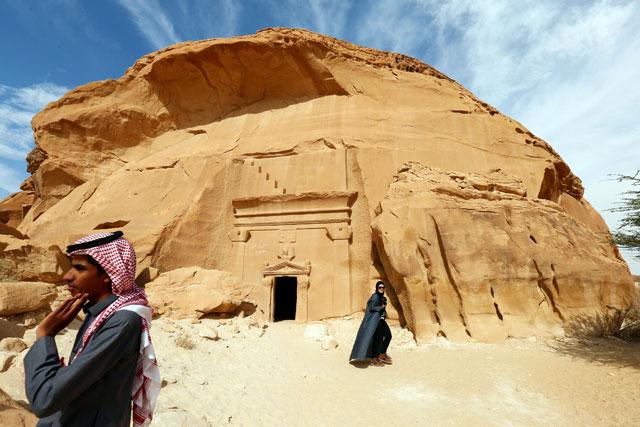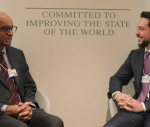You are here
Desert ruins of Al Ula: Saudis revive forgotten past
By AFP - Apr 12,2018 - Last updated at Apr 12,2018

A photo taken on March 31 shows a Saudi man walking near ancient tombs at the Khuraiba archaeological site near Saudi Arabia’s northwestern town of Al Ula (AFP photo)
AL ULA, Saudi Arabia — Trudging up a caramel-hued cliff pocked with ancient tombs, guide Bandar Al Anazi gazed at the stunning view: a windswept desert landscape of pre-Islamic ruins at the centre of Saudi-Franco preservation efforts.
Al Ula, an area rich in archaeological remnants, is seen as a jewel in the crown of future Saudi attractions as the austere kingdom prepares to issue tourist visas for the first time — opening up one of the last frontiers of global tourism.
“All of Al Ula is an open air museum,” Anazi said during a media tour just days before Prince Mohammed’s trip, revealing a patchwork of rock-cut tombs containing niches for burials.
“There is so much history here still waiting to be discovered.”
The tombs, some containing pre-Islamic inscriptions and drawings such as hunting scenes, are a legacy of the Nabataean artistic tradition.
The chiseled rock art forms could help unravel the mysteries of millennia-old civilisations on the Arabian Peninsula.
The area, roughly the size of Belgium, served as an important way station and bedouin watering hole on the trade route linking the Arabian Peninsula, North Africa and India.
It is home to the kingdom’s first UNESCO World Heritage Site, Madain Saleh, built more than 2,000 years ago by the Nabataeans.
“Every day something new is being discovered,” Jamie Quartermaine, an expert from the Britain-based Oxford Archaeology group, told AFP.
“The potential is endless. Look behind you,” he said, pointing at ancient animal art depictions engraved on a rocky spur inside an Al Ula hotel resort.
‘Gift to world’
A helicopter tour of the area revealed a desert landscape that appeared like the top of a foamed latte, dotted with heritage sites and towering maze-like rock formations.
The Saudi-Franco partnership is in part aimed at preserving the site from further erosion and vandalism it has faced.
At one archeological site called Al Khoraiba, Anazi pointed at a bereft cistern.
Photos taken by French explorers Jaussen and Savignac, who visited the area in the early 20th century, showed the same cistern once featured the statue of a deity.
The walled city of Al Ula, with tightly packed mud-brick and stone houses that were inhabited until modern times, sits decaying under the scorching sun.
But before a preservation plan is launched in collaboration with France, all archaeological treasures need to be accounted for, said Amr Al Madani, head of the Royal Al Ula Commission.
A massive two-year surveying programme began in March, which includes scanning via helicopters, satellites, drones and a remote sensing technology called Lidar, he told AFP.
“This is a significant undertaking incorporating all levels of survey from aerial survey down to ground checking,” said Quartermaine.
A Franco-Saudi deal to develop Al Ula calls for the creation of a dedicated agency modelled on the lines of the French museums agency, which spearheaded the establishment of the Louvre museum in Abu Dhabi.
At least one large museum is planned to be built in Al Ula.
Gerard Mestrallet, the former CEO of French electric utility company Engie, has been appointed special envoy of French President Emmanuel Macron for Al Ula.
Al Ula is expected to fully open up to global tourists within three to five years, launching the site as what Saudi officials describe as “a gift to the world”.
‘Pride in our past’
Al Ula is among a hidden trove of Saudi archaeological treasures.
Archaeologists last year used Google Maps to find hundreds of stone “gates” built from rock in a remote Saudi desert, which may date back as far as 7,000 years.
They also discovered evidence of 46 lakes believed to have existed in Saudi Arabia’s northern Nefud Desert, which experts say has lent credence to the theory that the region swung between periods of desertification and a wetter climate.
Tourism is one of the centrepieces of the blueprint to prepare the biggest Arab economy for the post-oil era. Al Ula’s hotel infrastructure is currently inadequate, with only two facilities with a capacity of 120 rooms.
But the project is about reviving the glory of Saudi Arabia’s ancient past.
There is currently scant information in Saudi history textbooks about Al Ula.
“This is about national pride in our own past,” Anazi said.
Related Articles
AL ULA, Saudi Arabia — Bathed in light, musicians belt out melodies among pre-Islamic desert ruins in northwestern Saudi
AL ULA, Saudi Arabia — In a remote northern corner of Saudi Arabia sit the relics of an ancient civilisation, which the kingdom hopes to tur
RIYADH — Saudi Arabia is preserving pre-Islamic heritage sites, like a date palm oasis from the Stone Age, in a break with the austere strai


















